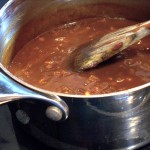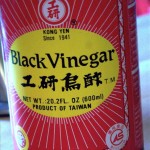16
2009
Maracue Sauce
I bought a zillion pork tenderloins a couple of weeks ago, waging on a suspicion that pork would be on sale because of the swine flu. I was right! Four pork tenderloins later and two weeks to payday, I needed something to cook for dinner. I’ve been making pork in sherry marinade and am ready to try something different for preparation. I decided to make barbecue sauce. Last year, I made my own barbecue sauce a couple of times and found that it’s pretty easy to do and fun to make. Thus, I present a barbecue sauce recipe of my own invention with nods to a recipe found in Cook’s Country as well as some recipes from Martha Stewart. Cook’s Country proposed a layer of Chinese five-spice powder underneath a Coke-based barbecue sauce, which intrigued me. I wanted to keep it somewhat traditional with stuff like molasses and ketchup and mustard powder, though.
Anyhow, read on. It’s really effin’ good and should yield about two cups. I named it after myself in total modesty, roflololol.
Maracue Sauce!
- 1 sweet onion, minced
- 5 cloves garlic, minced
- 1 Tbsp olive oil
- 1/2 Tbsp crushed red pepper flake
- 1 tsp celery salt
- 1 tsp ground mustard
- 1 Tbsp Chinese five-spice powder
- 1/2 Tbsp chipotle chile powder
- 2 Tbsp Coca-Cola (Pepsi is for a-holes)
- 1 cup vegetable stock (Trader Joe’s is carrot-centric and works really well; I would try to use a carrot-rich broth. Meat broths or stocks would probably work, too)
- 1 cup ketchup
- 1 cup Chinese black vinegar (see below)
- 1 tbsp maple syrup (I had no brown sugar, so I used maple syrup since it was around)
- 1 tbsp blackstrap molasses
Heat olive oil in medium saucepan. When oil is hot, add onions and garlic and saute until translucent, about 5 minutes
Add crushed red pepper flakes, mustard, celery salt, ground chipotle, and stir until fragrant.
Add Coke, vegetable stock, and ketchup. Stir to combine and taste to adjust spicing if necessary. Add vinegar, syrup, and molasses. Taste for flavoring and adjust as necessary. Bring to a boil. Reduce heat and simmer for 30 minutes.
Can be used warm on meats or vegetables or can be cooled and stored. Should keep in refrigerator for 3-5 days.
Yield: about 2 cups.
Weight Watchers points: 12 pts for whole recipe, 1 point for 8 “servings.”
About black vinegar:
What is black vinegar? I first encountered it at the New Shanghai restaurant in Boston’s Chinatown and if I’d had it before, I didn’t realize what it was. Black vinegar has a really complex taste that comes from the fermented grains that it’s made out of. I guess a lot of people who are familiar with cooking with it (more than I!) say it’s somewhat like balsamic vinegar. I found a pretty good description of it elsewhere on the internets that I’ll copy and paste because it’s way the hell better than anything I could say. From wisegeek.com:
Black vinegar is a type of vinegar which originated in China and spread across much of Asia, along with many other originally Chinese foods. It can be made with a wide assortment of ingredients, and an array of formulas produce black vinegar, so there is an immense variance in taste. Like other vinegars, black vinegar is made by fermenting something, in this case grain, and then allowing the resulting liquid to age. After aging, the vinegar is bottled for sale.
Many cooks compare black vinegar to balsamic vinegar, since the two foods have similar flavor profiles. Both are typically aged, leading to a more complex, rich flavor. Both are also dark in color, with black vinegar ranging from reddish brown to true, inky black. However, the base ingredient of black vinegar is grain, not grapes, and this leads to a different end flavor. In addition, high quality balsamic vinegar is usually fairly uniform in flavor, while high-end black vinegar varies widely in taste from nation to nation and province to province.
Rice, wheat, millet, sorghum, and barley are all fermented to make black vinegar. Many people prefer black vinegar made from rice, since it has a slightly sweet flavor to compliment the familiar acidic note found in vinegar. One of the most popular varieties of black vinegar is Chinkiang, which is made with glutinous rice and malt, leading to a sweet and complicated flavor.



